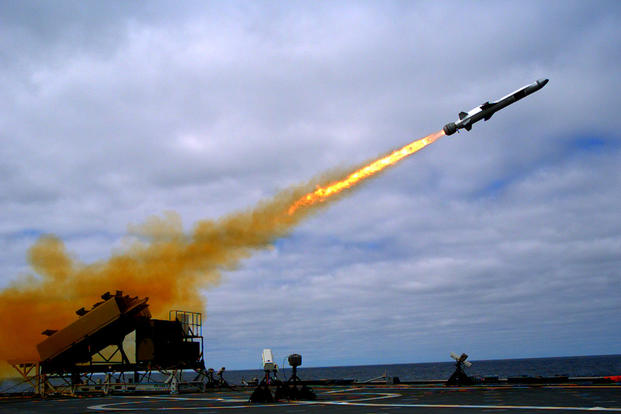The U.S. Navy is moving ahead with plans to bolster the firepower of its littoral combat ships, adding new capabilities to the vessels that will improve their lethality and survivability in a conflict, a Lockheed Martin executive said Jan. 17.
Plans are underway to equip the LCS with the Naval Strike Missile, an over-the-horizon anti-ship missile made by the Norwegian company Kongsberg Defence and Raytheon that Joe DePietro, Lockheed's vice president of small combatants and ship systems, described as having a "long-range surface-to-surface capability that exceeds what the [Boeing-made] Harpoons can do today on current surface combatants."
The Navy also plans to add the Surface Electronic Warfare Information Program, or SEWIP, Block 2 electronic surveillance sensors to the vessels and the MK 53 Decoy Launching System, or Nulka, to protect against inbound missiles.
DePietro said the service hopes to put the NSM on all LCS platforms, starting with those slated to deploy in 2020.
"Having some of these capabilities helps it to be in a position to be more 'a little bit scout, a little bit more offensive,' have a little more capability to be integrated with cruisers and destroyers," he said.
The changes are being made to the ships -- the oldest is less than 10 years old -- out of concerns for their ability to handle a changing mission set. The LCS initially was built to conduct operations in the shallows, including defense, anti-surface warfare and mine counter-measures. It now will need to perform those missions and more as China and Russia assert their maritime power, DePietro said.
"What's been changing with our near-peer threats is really driving some of this. The flexibility of this ship allows it to go places where other ships can't go. But while we are putting it in these places, given the change in the threat, we need to have additional capabilities inherent to the ship," he said.
Of the 32 LCSs the Navy plans to commission, 16 have been delivered, including LCSs 1-14, 16 and 18. The USS Wichita, LCS-13, was the most recent to be commissioned, earlier this month in Mayport, Florida.
According to the Navy, 10 additional LCSs are under construction, and three are in the pre-construction phase.
The LCS has been built in two variants: the Independence variant, built by Austal USA in Mobile, Alabama, and the Freedom variant, built by Lockheed and Fincantieri Marinette Marine in Marinette, Wisconsin. Of the Navy's current LCS fleet, seven are Freedom variants and nine are Independence.
The modernization upgrades -- being designed by Lockheed Martin -- will go on both variants, DePietro said.
The NSM has a range of more than 100 nautical miles and advanced target recognition capabilities that allow it to reach a target without needing additional ships or aircraft to maintain the track.
The LCSs currently are equipped with a 57mm rapid-fire gun and launcher able to fire the RIM-116 Rolling Airframe Missile, or RAM. It also can accommodate armed MH-60R Sea Hawk helicopters and unarmed MQ-8B Fire Scout aerial systems.
The LCS program has had its share of setbacks and controversies, including problems over design and construction issues with the early ships and concerns about the class's survivability and effectiveness in battle.
Three LCSs deployed between 2014 and 2016, with floats lasting from 18 to 23 months in the case of the USS Fort Worth, LCS-3, which was stuck in the port of Singapore for an extended period after experiencing a major setback when its combining gear was run without oil. The USS Coronado, LCS-4, also broke down on its way out to the Pacific.
None of the ships deployed in 2018 due to maintenance scheduling issues. Navy officials said earlier this year that at least three LCSs will deploy in fall 2019.
Last May, the Pentagon awarded a $14.8 million contract to Raytheon for the initial Naval Strike Missile buy. The contract is worth up to $847.6 million if all options are exercised.
Lockheed is managing the design integration portion of the contract, starting with LCS-7, the USS Detroit.
-- Patricia Kime can be reached at Patricia.Kime@Military.com. Follow her on Twitter @patriciakime.










